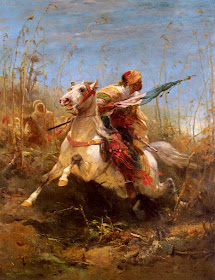Adolf Schreyer (July 9, 1828
Frankfurt-am-Main – July 29, 1899
Kronberg im Taunus) was a
German painter, associated with the
Düsseldorf school of painting.
Biography
He studied
art first at the
Städel Institute in his native town, and then at
Stuttgart and
Munich. He painted many of his favourite subjects in his travels in the East. He first accompanied Prince
Thurn and Taxis through
Hungary,
Wallachia,
Russia and
Turkey; then, in 1854, he followed the
Austrian army across the Wallachian frontier. In 1856 he went to
Egypt and
Syria, and in 1861 to
Algiers. In 1862 he settled in
Paris, but returned to Germany in 1870; and settled at
Cronberg near Frankfurt, where he died.
Work

Arab Horsemen by Schreyer
Schreyer was, and is still, especially esteemed as a painter of
horses, of
peasant life in Wallachia and
Moldavia,
and of battle incidents. His work is remarkable for its excellent
equine draughtsmanship, and for the artist's power of observation and
forceful statement; and has found particular favour among French and
American collectors. Of his battle-pictures there are two at the
Schwerin Gallery, and others in the collection of Count
Mensdorff-Pouilly and in the
Raven Gallery, Berlin. His painting of a
Charge of Artillery of Imperial Guard was formerly at the
Luxembourg Museum. The
Metropolitan Museum, New York owns three of Schreyer's
oriental paintings:
Abandoned,
Arabs on the March and
Arabs making a detour; and many of his best pictures are in the
Rockefeller family,
Vanderbilt family,
John Jacob Astor,
William Backhouse Astor, Sr.,
August Belmont, and
William Walters collections. At the
Kunsthalle in
Hamburg is his
Wallachian Transport Train, and at the Staedel Institute, Frankfort, are two of his Wallachian scenes.
References
External links
Chisholm, Hugh, ed. (1911). "Schreyer, Adolf". Encyclopædia Britannica (11th ed.). Cambridge University Press.
Chisholm, Hugh, ed. (1920). "Schreyer, Adolf". Encyclopædia Britannica (11th ed.). Cambridge University Press.



















No comments:
Post a Comment